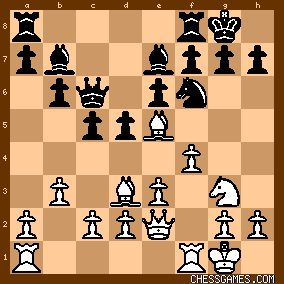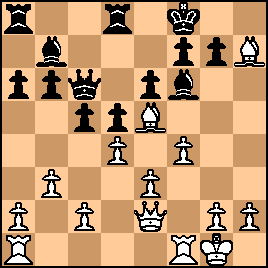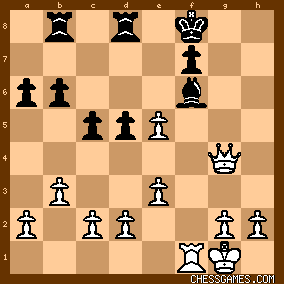|
< Earlier Kibitzing · PAGE 7 OF 7 ·
Later Kibitzing> |
Nov-03-13
 | | Richard Taylor: Great game. Thanks to <Perfidious> for alerting me (and others I assume) to this game. |
|
| Feb-10-14 | | jdc2: Kind of amazing how many games involving this particular type of sacrifice there
are, for example:
Gelfand vs Kramnik, 1994
and
A Stefanova vs N Kosintseva, 2012 |
|
| Feb-14-14 | | tzar: I think this game became a model for future players as far as bishop against King's pawns sacs are concerned. |
|
| Dec-16-14 | | kereru: 38.Qxd3 has a nice air of sarcasm about it |
|
| May-12-15 | | whiteshark: < RandomVisitor: 13...g6 would put a stop to white's excellent kingside adventure.> Right and 13.Qe2 wasn't necessary for the combination, too. |
|
| May-02-16 | | Albion 1959: I first saw this game back in 1977 in a copy of Irving Chernev's The Golden Dozen. I recall that in the book, black resigned at move 33 and not 38. Chernev did tend not carry on with the actual score and simply put resigned where he thought it appropriate. He also made a comment that this was the only time in his long and illustrious career that Lasker ever played The Bird's Opening !! |
|
| May-21-16 | | PJs Studio: Dr Lasker's efficiency in this game is beautiful. Reminds me of Fischer. |
|
Feb-22-17
 | | Jimmy720: memorize |
|
| Jun-01-17 | | Iwer Sonsch: <<whiteshark> 13.Qe2 wasn't necessary for the combination, too.> Looks like it. In the actual combination, Qe2 just throws away a tempo, so why allow <13...g6!>? Actually, it's a bit deeper. As my Stockfish 7 points out, 13...d4!, putting up the threat of ...Qxg2# and simultaneously covering f3 against the rook, causes difficulties for White and, in the end, successfully defends (13.Nh5 d4! 14.Rf2! dxe3 15.dxe3 Nxh5 16.Qxh5 with 0.17 @depth 29; 16.Bxh7+ Kxh7 and 21.Qh5+ Kg7 22.Qg4+ or 22.Rf3 Qxf3 23.gxf3 is equal). Objectively, 13.Nh5 d4! 14.Rf2! is still a tiny bit stronger than 13.Qe2(!) g6! (-0.18 @depth 25), but from a human's point of view, 13.Qe2(!) looks way less suspicious than the immediate 13.Nh5: <"He's played his queen alongside the d1-e2 diagonal. He can't be planning Qh5 anytime soon, can he?">, Bauer might have thought. |
|
| Jun-01-17 | | Iwer Sonsch: <13.Qe2(!) a6? 14.Nh5!> d4 15.Nxg7 Kxg7 16.Qg4+ Kh8 17.Qh3 Qxg2+ 18.Qxg2 Bxg2 19.Kxg2 still gains the Bishop pair and a decent positional advantage:

click for larger view1.46 @depth 25 (Stockfish 7) |
|
| Jun-01-17 | | Iwer Sonsch: I really gained the opinion that 13.Qe2(!!) was the winning move for Lasker, as it let Bauer without any foresight about the upcoming attack. |
|
| Jun-01-17 | | Iwer Sonsch: Lasker's combination from move 26 on was really beautiful and, without the a-, b-, c-, d-, g-, and h-pawn, would make up a really nice puzzle. Of course, most of the moves look pretty clear-cut, but would you still calmly play them at a -3 material disadvantage? |
|
| Oct-16-17 | | DrAnderson: Lasker vs J Bauer, 1889.
YOU ARE PLAYING THE ROLE OF LASKER.
Your score: 89 (par = 79)
Who did better? |
|
| Oct-17-17 | | Boomie: <DrAnderson: Lasker vs J Bauer, 1889.
YOU ARE PLAYING THE ROLE OF LASKER.
Your score: 89 (par = 79)
Who did better?>
I got 91 but got credit for a lot of moves that weren't played. Oddly I've never played guess the move before. |
|
| Nov-21-17 | | Donkey255: <Who got better?>
I got 104. |
|
Apr-11-18
 | | tpstar: <What criteria must exist in order to start thinking that a double bishop sacrifice might work? First, obviously, you need your bishops pointing at h7 and g7. And of course those squares must be protected only by the king (no knight on f8, for example). Furthermore it's important that the king cannot escape via f7-f8 (or f1-f2 in the case of White). Typically this would be because of the rook and pawn on those squares, although I could imagine other cases. It's also important that you have a rook ready to move in for the kill. Finally, perhaps most important of all, when that rook comes out to threaten mate, Black must have no good way to block the imminent check. This is usually the result of having too few pieces defending the kingside.> A teaching video used the term "piece fist" which was new to me, with three pieces attacking an undefended Kingside. <Strangely, despite Lasker's success with Bird's Opening, he never again played it in his life!> One and done.
<Bauer should have played g6! on move 13, this prevents any chance of a Bishop sacrifice on h7, there was no time for such luxuries such as a6?? this was far too slow, but after Nh5 on move 14, the attack was under way and appears that there was not a lot that could have been done to stop it: Lasker had too many open lines for his pieces. This is very subtle and the flaws in Nxe5 and a6 are difficult to appreciate until looked at with close analysis.> <Surely it's not a perfect game what with Bauer doing nothing despite the fact that Lasker's bishops are all hungrily eyeing his kingside, but who would have conceived this beautiful attack could be possible (well, Lasker)?> *****
<For the record, here is Kasparov annotating the game at its key moment in On My Great Predecessors part I:> <13.Qe2! A psychologically subtle move: both prophylactically defending g2, and threatening Bb5, which in fact is a sham - the bishop is looking in quite the opposite direction!> <Kasparov then gives lines to show why the combination would not have worked with the queen left on d1 (13.Nh5), as some has suggested.> *****
<Soltis gives 6. Nf3 and 7. Nc3 as the right move order in his recent opus "Why Lasker Matters." I think he's probably got it right since the order given above allows black the possibility of 6 ... d4.> <I like how Lasker blocked his center pawns and almost single-mindedly attacked the kingside, then suddenly, out of nowhere, as it were, with Black having apparently done nothing wrong, Lasker unleashes a spectacular and original combination, with the final point having nothing to do with the kingside at all, but simply exploiting the line-up of the enemy bishops, which he must have had in mind before starting the attack!> <Blacks Nbd7 is a fine move, it strengthens his f6-square, which takes some of the punch out of whites bishops in theory, although the main reason for it is mainly because its a fine square for the knight, it's developing the piece, and it's NOT blocking in his bishop on b7.
As for c5, it is indeed dubious, Nc5! (another reason Nbd7 was a fine move) would have been much better as it would have eliminated one of whites powerful bishops. Although the biggest black mistake IMHO in that he did not play ...3 d4, when no matter what whites pawn structure is shattered, one reason to play Nf3 early on as white in the Bird's. Although, those moves were typical of the style of the ages, and although nowadays most strong players would find d4 and Nc5 immediately, that wasn't the way it was played then and you can't compare different eras. Overall though, a fantastic attack by Lasker, and one of my all-time favorite combinations.> <11 ...Nxe5 This is also not bad, but black should have taken advantage of a tactical opportunity and strike with 11...d4!, which is a common theme in the queen side fianchetto lines: black shuts out the dark-squared bishop. here it works, despite insufficient control of d4, because of a tactic based on the exposed g1-a7 diagonal. After 11...d4! play might continue 12.cxd4 cxd4 13.Bxd4 Bc5 (the tactic mentioned above) 14. c3 Nxe5 15. fxe5 Qxe5 and black is slightly better. Therefore white should not take the pawn but instead play 13. Qe2 when 13...Qd6 leads to an approximately equal game, as white has kingside play, but his bishop suffers.> Game Collection: Double Bishop Sacrifices (dedicated to Anatoly K |
|
| Apr-15-18 | | pdxjjb: Analyzing this with a modern engine is interesting. First, if you watch closely, the engine thinks 13 ... a6 is a pretty reasonable move out to 20 ply search depth or so; only when the search gets very deep does the engine decide it's not such a good idea. Second, the engine thinks 14 Nh5 is only worth a pawn-and-change, had Bauer made the correct response; but the "correct" responses are (imho) "inhuman" (moving the f-rook to the a-side, e.g. Rfb8). And finally, after 14 ... Nxh5, the engine has to hit like 14 ply before it sees Lasker's winning line. 14 ply! Sure, this happens in an eyeblink on modern computers, but c'mon, that's really deep already. Confirming that the whole combo was both unbelievably brilliant and completely sound - there is no hidden refutation for Bauer. |
|
| Nov-24-18 | | MrJafari: I think the climax of the game is sacrificing bishops... |
|
| Mar-01-19 | | Chessonly: Emanuel Lasker was mathematician, philosopher and remained world champion for 27 years. https://www.chessonly.com/emanuel-l... |
|
| Oct-02-19 | | LawrenceBernstein: Fantastic pun: "Emanuel Labor!"
Lasker's Qxd3 is a show of disdain for an idiot who's overdue to resign. Of course, Herr Bauer resigned immediately afterward. |
|
| May-21-20 | | MrCalculater: I calculated all my might on 13...a6 and found out it's good, but once I got some help from the computer I found out I'm wrong |
|
| Nov-02-20 | | kaimann: Statistician Jeff Sonas of Chessmetrics writes, "if you look across players' entire careers, there is a significant amount of statistical evidence to support the claim that Emanuel Lasker was, in fact, the most dominant player of all time." !!! |
|
| Feb-13-23 | | generror: I'm a pretty huge admirer of Lasker, but so far I haven't yet had a closer look at his games. So I was looking forward to this one, the double bishop sacrifice classic played at his first international tournament. And I can already say it was a joy to analyze it -- it's got everything that makes Lasker so great! Even the first move could be called "Lasker-esque". Imagine yourself at age 20, playing your first game in your first international tournament, and your choice for your first move is <1.f4?!>. I'm sure Lasker knew about the dangers of that romantic KP4, so let me just add "boldness" to the list of why I admire him. (This seems to be the only serious game where he used this opening, by the way.) Blocking his d-pawn with <5.Bd3?!> also isn't what I or Stockfish expected; but strangely, and as often with Lasker, the game proves him right. It feels as if Lasker had prepared his double bishop sac just for this occasion. It definitively was on his mind pretty early, and the reason for why he plays another relatively dubious move, <11.Ne5>. After Black's obvious answer <11...Nxe5?> (D), he actually could have won a pawn with <12.fxe5 Ne4 13.Bxe4 dxe4 14.Qg4>, and I can't imagine he missed that. 
click for larger view<12.Bxe5?> however is a clear mistake according to Stockfish -- but these two "bad" moves clearly pave the way to Lasker's famous combination. <13.Qe2!?> (D) is another move that Stockfish doesn't like; Stockfish would have played <13.Nh5>, because even after <13...d4!>, White gets a slight (+0.5) advantage. 
click for larger viewBut Lasker didn't care for slight advantages and he chose <Qe2> because not only does it defend f2 against <...d4>, but mainly because it sets a neat trap by threatening <Bb5>. And poor Bauer immediately falls for it -- but <13...a6??> is already losing. If he would have concentrated on the kingside, he might have found <13...Nd7!> which would have prevented Lasker's plan with <14.Nh5 f6> -- and an immediate <14.Bxh7+> only results into perpetual check, and Lasker clearly didn't care for that either :) |
|
| Feb-13-23 | | generror: After <14.Nh5!>, Black could only have saved himself from immediate destruction by getting his king to safety with <14...Rfd8>, so after <15.Nxf6+ Bxf6 16.Bxh7!> the king can escape via <16...Kf8> (<16...Kxh7? 17.Qh5+> is not recommended), but even then White is up a pawn and after <17.d4> (D) has a very comfortable, if not winning, position.
click for larger view<14...d4?!> could also have held a little longer, but after <14...Nxh5??>, Black might as well resign. I was glad to see that Lasker's sacrifices -- unlike many other 19th-century sacrifices I've analyzed -- are completely safe and sound. It's also very pragmatic: He forces Black to give up his queen to prevent mate, and then via <22.Qd7!> wins a piece (and threatens to eat a lot of Black's pawns). Black now tries to get his king to safety, and by <24.Rf1!>, Lasker ensures that he won't cross the f-file. It's another nice little trap into which Bauer walks unsuspectingly, and as soon as walks onto f8, <27.fxe5!> (D) begins another combination that I actually like just as much as the bishop sacs. 
click for larger viewAnd again, it's completely sound, Black has no way to prevent white from winning more material. I just love how Black is forced to play <29...f6> only to get the crushing <30.Rxf6!> (in yo' *face* XD) -- and all this resulting in Lasker winning the exchange in addition to the piece. I have to hand it to Bauer that he keeps on fighting even after <34.Qxb7>, because I like how Lasker then finishes the game by just simplifying the position into a clearly won king-and-pawn endgame with <38.Qxd3!>. This is standard playing today of course, but I'm not sure many masters of the 1880s would have been so level-headed. So yeah, definitively one very nice game. Even from this one game, it's clear that Lasker was definitively someone to reckon with. None of Steinitz' risky defensiveness, but also none of the unsound romantic attacking -- this game shows that his pragmatic style is the dialectic synthesis of both, and this does indeed explain to me why he would dominate chess for the next 25 years. |
|
| Jun-14-24 | | BxChess: This game features in the book `While Justice Sleeps' by Stacey Abrams. A political thriller, which I found entertaining, although it was difficult to keep my disbelief suppressed. The extended metaphor for the game is that the protagonist, a feisty female lawyer (aren't they all?) was one of the sacrificial bishops set to trap the American president into a weak move.
In the way of these thing, there are a few passages of expository material on chess and its history. Its a bit clunky but one line I liked made the point that the most powerful piece, the queen, is in service to the much weaker king.
The book is ok but not a patch on the game. |
|
 |
 |
|
< Earlier Kibitzing · PAGE 7 OF 7 ·
Later Kibitzing> |
|
|
|





